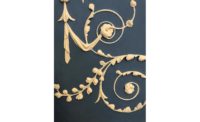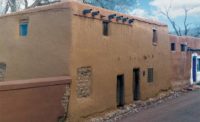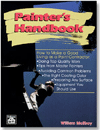In our previous article, we were introduced to binders, the “mineral glue,” that holds our plaster together. Now it’s time to consider the “things,” the aggregates and occasionally fibers that typically compose the greater percentage of the volume and mass of a plaster. While it’s true that most aggregates and fibers are less costly than our precious binders, they’re certainly not cheap fill material. Rather, they play a very active role in the strength and performance of plasters, stuccos and mortars. Furthermore, they contribute significantly to the aesthetic quality of the finish, that is to say, how pleasing to the eye the plaster will be. Let’s approach our consideration of aggregates and fibers by considering their various physical properties.
Sharpness
It seems intuitive that if your aggregates are sharp and jagged, it will be easier for the binder, such as clay or lime, to find a “key” or “bond,” which are terms we use to describe how plasters develop strength internally and on the surfaces they are applied. Aggregate sharpness can be very important for clays and limes, which shrink as they dry, threatening to crack or otherwise weaken the plaster. Crushed sand and glass are examples of very sharp aggregates that can help overcome this weakening effect, permitting the application of thicker base coats.
Nevertheless, sharper is not always better. A disadvantage of sharp aggregates is that they make it quite challenging to achieve a smooth finish. Often plasterers will switch to a more rounded aggregate, such as a river or rinsed sea sand, for their final coat. Finish applications are applied relatively thin to minimize shrinkage, and the rounded nature of finish aggregates allows the plaster to be easily brought to a smooth finish with the trowel. Whether an aggregate is sharp or more rounded can be determined quickly and simply by rubbing it between the fingers.
Granulometry
Another approach to counteract the potential effects of shrinkage is to pay close attention to granulometry, the distribution of aggregates of various sizes within a plaster. Particularly for the thicker base coats it is important to have a small percentage of larger aggregates, a majority of medium size ones and again, a small portion of fines in the mix. This allows the aggregates to interlock most efficiently with the smallest quantity of binder required to fill the voids. For the thinner coats of finish work, a distribution within a range of finer aggregates permits the plasterer to create a smooth, closed surface. Usually a visual inspection in the hand will furnish a good indication if you have a sufficient distribution of aggregate sizes. Furthermore, graduated aggregate sieves are readily available for specifications that are more precise.
Hardness
By hardness, we’re actually referring to the more interesting quality of softness. Gypsums and certain natural cement binders have the unique and interesting characteristic of being “self-binding,” that is to say they don’t actually depend on aggregates to perform well as a plaster. That opens up a great deal of aesthetic freedom regarding what aggregates can be added to them. Often, softer aggregates such as chalk, porous limestones or crushed gypsum rocks are utilized. It only takes a short while before the binder becomes harder than the aggregates allowing the surface to be cut, sanded or otherwise honed to a smooth surface for a striking resemblance to actual limestone.
Porosity
Silica sand, crushed marble and glass are relatively impervious; however, I personally love the benefits of porous traditional aggregates such as crushed limestone, terracotta and pumice, especially when making lime plasters. I find such plasters more ductile, comparatively smoother to apply. The porous aggregates soak up water like a sponge. They can be particularly helpful for the “grounds” or base coats of fresco work. As water evaporates from the binder, it gradually and evenly is replenished from the porous aggregates maintaining the surface at the perfect level of humidity for buon fresco painting, extending the working time significantly.
Density
Being mineral-based, most aggregates range from medium to relative high density. However, a few exceptional minerals that produce lightweight aggregates. Among these are Perlite and Vermiculite. These minerals have water trapped in their crystalline structure. When heated sufficiently they “exfoliate” or expand dramatically, something akin to a mineral popcorn. The resulting aggregates are lightweight, have greater fire resistance and significantly increase the thermal and sound insulation value of plasters made with them.
Hydraulicity
Certain aggregates create a “hydraulic” or accelerated setting action in lime plasters. We’ll make this family of aggregates, known as “pozzolans” the focus of its own future essay.
Flexibility
In addition to aggregates, fibers can be a very useful addition to plaster binders. Straw and manure have been used for millennia to help reduce erosion in exterior clay-based earthen plasters. Horse, goat and other animal hairs increase the tensile or flexural strength of gypsum and lime plasters that are particularly useful for plasters applied over lath, which is subjected to greater shear forces than a similar application over masonry might experience. Burlap woven from hemp, jute, sisal or coconut fibers can be embedded into walls in large webs and are very effective for reinforcing as well as attaching traditional plaster moldings and ornament.
Hopefully this sheds a little light on the importance of aggregates, part of our overall effort to demystify the materials used and the means and methods applied for traditional plasterwork. In our next article, we’ll commence the first of a series of in-depth reviews of traditional plaster binders with the miraculous material that is clay, expanding upon its chemistry, manufacture, properties and potential specifications.








Report Abusive Comment